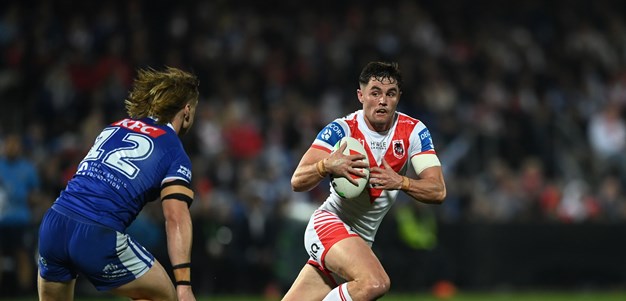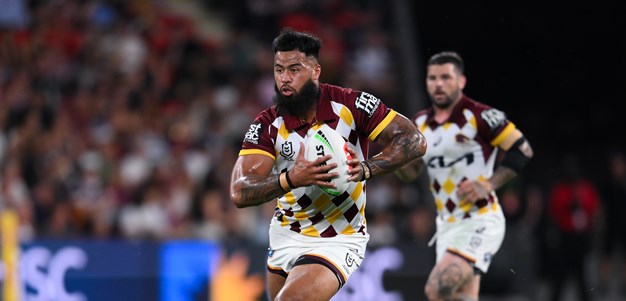
Six again. It comes with a bell instead of the whistle and has made a cacophony of noise in the NRL party over the past 18 months.
NRL coaches and recruitment staff are anticipating a similar impact where rugby league's real fun and games go unmatched: the player market.
Talent scouts and football managers are well aware - if they can't keep up with the latest trend they'll be watching from afar while other teams party in the playoffs.
The six-again spin-off is expected to be felt more and more as teams adjust accordingly, but already on the recruitment front:
- Big men are being marked for evolution rather than extinction, so too how they are scouted;
- "Eyes-up" types are only going to increase in value, but not necessarily for the highlight reel plays that attract the eyeballs;
- The bench is by no means the realm of a coach's next four best players even if one of them knows he very well could not see a minute of game time.
And as usual, Melbourne seem to have worked things out faster and better than everyone else.
Round 21 - Moses and Holmes back, Cleary could return
How six-again is shifting signings
Big boppers: evolution or extinction?
The natural wisdom of a game with more fatigue and fewer stoppages is the question Andrew Johns posited in The Sydney Morning Herald last week.
"Do we want almost every player on the field to be between 180cm and 185cm tall, and about 100kg, or is the really big man still relevant in the modern game?"
Without a doubt, small forwards like Cameron Murray and Victor Radley have come into their own in the past 18 months.
"Look at the two sides leading the competition," veteran Raiders scout Peter Mulholland says.
"Penrith's got the youngest forwards and the most energetic pack of forwards you'll ever see and their playmakers absolutely thrive off the energy of their forwards.
"And as for Melbourne, I think they'll always be up there because of their training effort. When was the last time you saw a Craig Bellamy side that was beaten for fitness or commitment?"
Indisputably, the Storm have adapted to the six-again rulings quicker and more efficiently than their 15 rivals.
Last year's premiership was won with Nelson Asofa-Solomona (200cm, 115 kg), Jesse Bromwich (194cm, 114kg), Christian Welch (195cm, 110kg) and Tino Fa'asuamaleaui (197cm, 110kg) who tip the scales well into three figures, while Tui Kamikamica (195kg, 110cm) is cut in the same mould from Fijian granite.
"If you can't keep up, you won't last long with us," long-time Storm chief of recruitment Paul Bunn says simply.
NSW ran roughshod over Queensland with Junior Paulo (123 kg), Daniel Saifiti and Payne Haas (117 kg), all ranking as not only the three best props in the game, but the biggest.
Knights v Broncos - Round 21
The Blues trio are the absolute elite, but as one Sydney-based football manager points out, "a big ball-playing forward can be a nightmare under the new rules".
"He can wind right up, find the ground, get a quick play-the-ball and cause some real damage in a 15-20 minute period.
"Other games, a bloke can be on for 10 minutes and he won't see the ball. He has to defend that entire period and can fatigue very quickly in those back-to-back defensive sets."
New Broncos head of football Ben Ikin has his feet under the desk at Red Hill and his colour-coded spreadsheets organised alphabetically as he tackles a roster badly bent out of shape by too many big men on too much.
Ikin's are relatively fresh eyes in the recruitment game, though it has been a "hobby horse" of his for years.
The GPS data that confirms Haas as "an absolute freak physiologically," is readily available for all at the Broncos, and hardly necessary in any case.
Big men with motors like Haas are worth their considerable weight in gold, and can be easily identified. Where Ikin sees a potential recruitment edge is the next tier down.
Haas shows he can just about do it all!
"It's easy with the players you've got because obviously you monitor them," Ikin says.
"But in the market, there's limited opportunities to do that when you're recruiting.
"You might create visual flags when you're watching video of a player.
"Clubs don't share GPS data obviously, but those repeated efforts are becoming more and more important in the game.
"Identifying what that looks like in your recruitment is the potential next step as the game adapts to the six-again."
The eyes have it – Why Storm streets ahead as usual
Opening up a congested game for the ad-lib, "eyes-up footy" type of player is the whole point of the NRL's six-again rules and change in set restarts.
Teen tyros Reece Walsh and Sam Walker have flourished from their first NRL outings, the rugby league smarts and fullback instincts Tom Trbojevic and Latrell Mitchell stole the show in Origin, and players raised on touch football like Nicho Hynes and Ryan Papenhuyzen have found ample reward for their rapid-fire, response-based play.
Having started as the Broncos football manager during the Super League before what has now been a decade replenishing the Storm's conveyor belt of talent, Paul Bunn has seen plenty in his time.
The Storm create a try when all looked lost
And he doesn't see the six-again rules changing much at the Storm. Because they changed five or six years ago.
"What we've had in place for a while might actually suit it," Bunn tells NRL.com.
"Playing wise we've got more ball movement in the game I'd say, and that's something we've thought about as a club for a while.
"Jahrome Hughes for example, Paps, Nicho Hynes and Cam Munster these guys who can just read a game, and we genuinely really began prioritising that type of player for us several years ago.
"Brandon Smith and Harry Grant are the same. They're all always at the line and ready to go with off-the-cuff footy."
The ability to spot an opportunity, and make the most of it, is the basic concept behind the "eyes up" cliché.
Williams sees space and grabs a double
But in a game where momentum has been heightened like never before, Mulholland points to Canberra's round 17 upset of high-flying Manly for a different interpretation.
By no means sexy "eyes up" stuff, but just as influential.
"That game against Manly, we had Sam Williams and Matt Frawley force eight drop-outs between them, I can't recall kicking like that in a long, long time," Mulholland says.
"You've still got to have game management, especially with a kicking game to set you up early on in a game.
"That will still be at least one half of your playmaking if not more.
"As the game wears on and the fatigue factor sets in, that's when there's less structure, but you can potentially set that up with your kicking game.
"One side can dominate possession and almost put a game away if they kick well and dominate it early."
As intended but the NRL's powerbrokers, genuine "footballers" are tipped to be more valuable recruits in coming seasons.
Not just the jack-in-the-box attacking threats. But as Bunn says, an offloading forward like Sharks veteran Aaron Woods.
Old Tiger Woods open to homecoming
"You can see it in him that he's got a footballer's brain for a front-rower. Whereas your athletes, they're a dime a dozen, but are they going to have an influence on the game?"
Or as Ikin offers, players with genuine spatial and game awareness.
"It's about matching football with tempo," he says.
"A 40/20 or early kick, that's playing what you see, but not in the light-em-up flash of brilliance style playmaking most would think.
"Good communication is equally important there because you can go longer periods without the ball now.
"So a fullback who organises your defensive line well, edge players that are good decision makers, there's two sides of the ball, and it's a football-based aspect, not as much an athletic aspect."
Ponissi: Why strong clubs will blossom in uncertain times
Everywhere men - value in versatility and on bench
Where once rugby league's rules dictated a team's starting 13 was simply their best baker's dozen with the bench filled by their next four, the 2021 season especially has shaken that traditional thinking.
Case in point: The Gold Coast starting David Fifita – the game's highest-paid forward and a multimillion-dollar marquee signing – on the pine.
Drilling deeper, the six-again rules and more stringent concussion protocols have shifted tactical use of the bench for several coaches.
Their recruitment staff in turn shift their focus when filling a top 30 because, they say, the way a team is coached is the most important factor in the way you sign players.
Eels coach Brad Arthur told NRL.com in April that Parramatta's 2020 finals fade-out and new NRL rules had expressly dictated his pursuit of impact forwards like Isaiah Papali'i, Bryce Cartwright and Keegan Hipgrave.
"There's more ball-in-play time and less rest [in 2021], that's what the GPS numbers are telling us - there's less rest intervals and they're a lot shorter," Arthur said.
"And that's why the bench is so important, if you can get fresh legs on at the right time, you can speed up the tempo on your terms."
The mighty motors on Reagan Campbell-Gillard, Junior Paulo and Nathan Brown allow for the relative luxury of a Cartwright to be used sparingly as a game dictates.
Elsewhere the likes of Cronulla, Manly and Canberra have played with effectively 16 men throughout the season.
"It's not just the six-again but also the HIA impact as well," Sharks football manager Darren Mooney says.
Every try from Round 20
"That rule change has probably been as significant in terms of if you lose a winger for instance, you need to make sure you've got versatile forwards who can shift out wide or you carry an outside back on the bench."
Outside back Mawene Hiroti played just 26 minutes across three games last month – and spent the entire 80 as an unused 17th man against Brisbane – as Cronulla's starting back five played out each contest.
Shaun Johnson's season-ending injury against Canterbury though saw Hiroti off the bench for more than half a game and utility Connor Tracey's value made plain as he shuffled from centre to the halves, his fourth position of 2021.
Multi-positional players are often where recruitment managers do their best work, theoretically covering two and three roster spots while only spending on one player.
Mulholland sees the value in versatility only rising under the six-again rule.
"Look at Connor Watson, a utility player like him, the quick, speedy guys, they're going to benefit I think," he says.
"A fella like Cade Cust for Manly who can play seven, nine and six, that truly becomes invaluable."
Watson cops an offload from a kick contest to score
Whether the tactical shift sees a starting position – like the one Nicho Hynes is leaving Melbourne for Cronulla to nail down – become less of a bargaining chip is debatable.
"Players look at a list and think how do I fit into it and what do I want for a move – there's all sorts of reasons," says one Sydney-based football manager.
"Most players I think like to think of themselves as starting players, whether that's ego or how comfortable they are."




